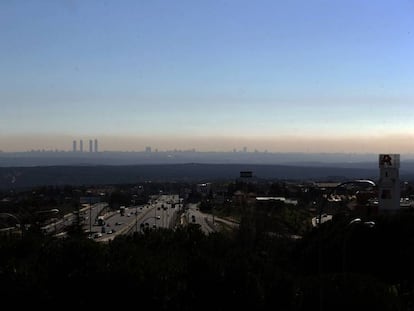The plastic polluting a piece of paradise in the Canaries
The island of La Graciosa is awash with waste from all parts of the world, and it just keeps coming in

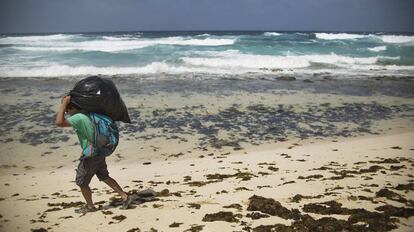
At Ámbar beach, the fight is only against the larger pieces of plastic. The battle against microplastics – bits of debris less than five millimeters in length – was lost long ago on this spot in the northeastern end of La Graciosa island, in the Canary archipelago.
At the rate the plastic washes in, it is as much as the volunteer beachcombers can do to pick up the more sizeable eyesores. “Now we’re focusing on the big pieces before they decompose in the sun,” says Alex Rivera, a biologist with the World Wildlife Fund (WWF).
Each season, volunteers pick up between 4,500kg and 6,000 kg of waste in the park Alex Rivera,WWF</span></span> b<span>iologist<br />
Like Sisyphus damned to push a rock uphill for all eternity, Rivera’s job is never done. For three months out of every year, he and the WWF volunteers tackle the accumulation of waste inside the Chinijo Archipelago Nature Reserve. And every Thursday during those three months, he leaves the park with a huge bag on his back filled mainly with plastic.
A week later, it is as though Rivera and the volunteers had never been here; plastic again is strewn along the shoreline as every day the sea spews more waste into this pocket of paradise. “The plastic comes from further north and also from southern Europe, the north of Africa and even from America, driven here by the currents,” says Rivera, referring to what has become one of the scourges of the 21st century.
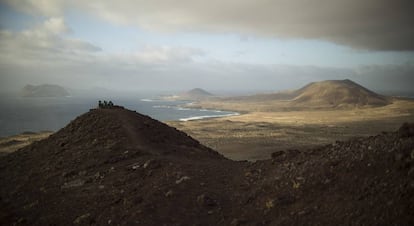
Our collective use of plastic, which took off in the 1950s, is now flooding areas like Chinijo, which is the Canary Islands’ most significant natural park as well as Europe’s biggest marine reserve. And Ambar beach, due to its location in the northeast of La Graciosa island, scoops up more than its fair share of the waste.
“This is where the planet’s trash ends up,” says Rivera. But it wasn’t always so. The British traveler George Glas referred to this “small sandy bay” in a book on the Canary Islands published in 1764. “In the north of the uninhabited island of La Graciosa, there’s a small sandy bay, called Ambar beach by the locals” he wrote. “Sometimes you can find a very good type of grey amber here, shaped like a pear.” Grey amber, or ambergris, is a valuable secretion made by a sperm whale’s digestive system, which was wont to wash up on beaches.
Enriqueta Romero, 78, who was born on La Graciosa, spent her childhood looking after her family’s goats and often went to Ambar beach. She remembers how the sea would then wash up various treasures following a storm or a shipwreck. “There were boxes of tobacco,” she says. “And once I found a tin of biscuits.” And every now and then there would be a plastic bottle. “It was like a gift,” she says, adding that she would always find some use for it.
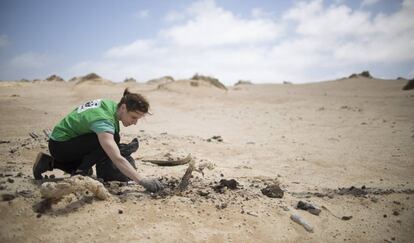
In 1950, when Romero was a 10-year-old, the world was producing around 1.7 million tons of plastic a year. In 2016, the amount produced was 335 million tons, according to PlasticsEurope. But the problem is not just the volume of plastic produced, but also its life span and the small amount that gets recycled. According to the European Commission, only 30% of plastic waste in the EU is collected for recycling. What is left behind often ends up in the sea or on the beaches.
The European Commission’s Joint Research Center (JRC) analyzed the rubbish on European beaches in 2016 and concluded that 84% was plastic. Another study published in Science in 2015 stated that eight million tons of plastic ends up in our oceans every year. Eventually, the oceans return the plastic to the beaches. “It’s a never-ending battle,” says Rivera.
According to a study of Ambar beach headed by Alicia Herrera from the University of Las Palmas, there is an alarming amount of waste smaller than 5 mm. The study highlighted the fact that 52.7% of the debris found in the sand was plastic fragments and 35.6% was oil products. “It’s one of the beaches that attracts the most rubbish in the Canary Islands due to its orientation,” says Alicia.
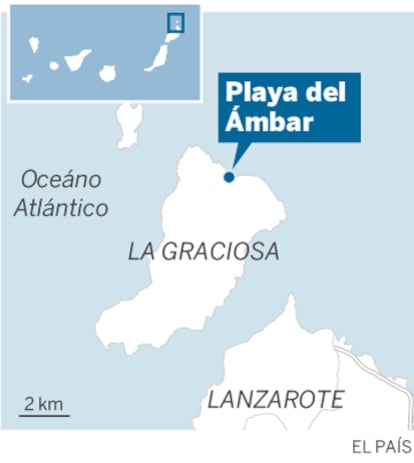
Oceans of plastic
“Each season, volunteers pick up between 4,500kg and 6,000kg of waste in the park,” says Rivera. Add to this the 20,000 kg collected by the National Parks Agency, which owns 98.5% of the 2,689 hectares that make up La Graciosa, the rest being two urban enclaves populated year round by 700 residents. As well as marine pollution, a vertiginous rise in tourism is another problem facing the area and the nature reserve was, in fact, established in 1986 as a way of countering this. There is also a degree of poaching affecting a species of bird known as pardela (shearwater). But the plastic waste remains the principle cause for concern. “Instead of grey amber, we now get oil blobs and plastics washing up here,” says Rivera.
Plastic waste is, of course, a global phenomenon that the UN is trying to tackle by persuading governments to introduce restrictive measures. Spain has recently passed a decree that will ban the use of free plastic bags in shops – a measure that is already in place in other EU countries. The European Commission, meanwhile, is introducing measures to limit the consumption of non-recyclable plastics. The goal, according to the Commission, is to reduce plastic waste that ends up destroying our oceans and natural beauty spots such as La Graciosa.
English version by Heather Galloway.
Tu suscripción se está usando en otro dispositivo
¿Quieres añadir otro usuario a tu suscripción?
Si continúas leyendo en este dispositivo, no se podrá leer en el otro.
FlechaTu suscripción se está usando en otro dispositivo y solo puedes acceder a EL PAÍS desde un dispositivo a la vez.
Si quieres compartir tu cuenta, cambia tu suscripción a la modalidad Premium, así podrás añadir otro usuario. Cada uno accederá con su propia cuenta de email, lo que os permitirá personalizar vuestra experiencia en EL PAÍS.
¿Tienes una suscripción de empresa? Accede aquí para contratar más cuentas.
En el caso de no saber quién está usando tu cuenta, te recomendamos cambiar tu contraseña aquí.
Si decides continuar compartiendo tu cuenta, este mensaje se mostrará en tu dispositivo y en el de la otra persona que está usando tu cuenta de forma indefinida, afectando a tu experiencia de lectura. Puedes consultar aquí los términos y condiciones de la suscripción digital.
More information
Archived In
Últimas noticias
The complicated life of Francesca Albanese: A rising figure in Italy but barred from every bank by Trump’s sanctions
Reinhard Genzel, Nobel laureate in physics: ‘One-minute videos will never give you the truth’
Pinochet’s victims grapple with José Antonio Kast’s rise in Chile
How Japan is trying to avert ‘digital defeat’
Most viewed
- Pablo Escobar’s hippos: A serious environmental problem, 40 years on
- Reinhard Genzel, Nobel laureate in physics: ‘One-minute videos will never give you the truth’
- Why we lost the habit of sleeping in two segments and how that changed our sense of time
- Charles Dubouloz, mountaineering star, retires at 36 with a farewell tour inspired by Walter Bonatti
- The Florida Keys tourist paradise is besieged by immigration agents: ‘We’ve never seen anything like this’

